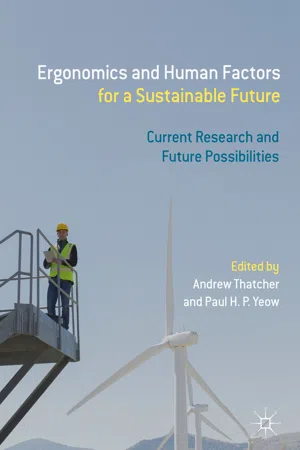Introduction: Defining the Problem
For most of human existence our species has had a fairly negligible impact on the planet. However, this changed roughly 250 years ago with the advent of the industrial revolution. The development of technologies powered by fossil fuels, rather than human or animal power, saw radical improvements in working conditions and living standards for the majority of people in what became known as the developed world. Further technological revolutions such as the development of electricity and significant advancements in medical care have seen further improvements in human wellbeing (Hecht et al., 2012). Once again, the people most likely to benefit from these innovations have been in the developed world. However, recently it has become evident that these developments also have significant negative consequences. These consequences can be sometimes artificially separated into environmental issues and social issues even though they are clearly interrelated. From an environmental perspective, the massive increase in the burning of fossil fuels has had a concomitant increase in the amount of greenhouse gases (GHGs) being released into our environment. The effect of increased GHGs , particularly into the atmosphere, has been a steady increase in global temperatures known as global climate change (Incropera, 2016). Scientists predict that an increase in the average global temperature of 2 °C will be catastrophic for human habitation of the planet (Hansen et al., 2016). From a social perspective, these developments have seen an explosion in the human population as people live longer, healthier lives. However, the benefits of these developments have not been consistently realised by people, leading to widespread social inequalities, especially based on access to financial and physical resources (Piketty, 2014; Stiglitz, 2015; Vitousek, Mooney, Lubchenco, & Melillo, 1997).
An increase in benefits for humans has led to environmental degradation as the carrying capacities of several key ecosystems have battled to maintain equilibrium with the rapid increase in the size of the population (Vitousek et al., 1997). What we are experiencing now as a planet is a complex web of interacting systems known as wicked problems (Incropera, 2016) or even super-wicked problems (Levin, Cashore, Bernstein, & Auld, 2012). Wicked and super-wicked problems are characterised by being difficult to define, where the leading causes of the problems (i.e. humans) are also expected to find the solutions, with no obvious right or wrong answers, and with rapidly approaching deadlines (Levin et al., 2012; Rittel & Webber, 1973). In fact, the influence of humans on the planet’s ecosystems is now so great that scientists have declared that we have entered a new geological epoch driven by human-led changes to geochemical cycles, the Anthropocene age (Steffen, Grinevald, Crutzen, & McNeill, 2011).
Thatcher and Yeow (2016a) characterised these interrelated problems as a set of three global asymmetries: resource asymmetries, asymmetries in the accumulation and distribution of waste, and legislative asymmetries (see Table 1.1). As far as resource asymmetries go, there are significant global imbalances in access to food, shelter, basic sanitation, healthcare, jobs, energy, clean water, education, consumer goods, productive land, and communication infrastructure (Hecht et al., 2012). This has led to poverty, famine, disease , and ultimately war as people fight over basic resources (Kelley, Mohtadi, Cane, Seager, & Kushnir, 2015). These asymmetries are also not good for the environment as people attempt to exploit increasingly marginal resources, leading them ever-closer to collapse (e.g. deforestation, polluted water, and land degradation ). Similarly, waste accumulation and distribution has occurred asymmetrically. For example, until recently carbon dioxide and other greenhouse gases were primarily released from technology in developed countries, but the effects will be felt worldwide and those least able to cope will be affected the worst (Samir & Lutz, 2017). The accumulations of carbon dioxide, heavy metal, plastic, nitrogen, and other wastes have already had detrimental effects on human health (Patz, Frumkin, Holloway, Vimont, & Haines, 2014; Pimentel et al., 2007) including respiratory problems, cancers, immune system defects, and birth defects. In addition, climate change accelerates these impacts through the spread of diseases to previously unknown geographical regions (Martens, 2013). Similarly, asymmetries in waste result in significant damage to ecosystems including nitrogen eutrophication of land and water (Rabotyagov, Kling, Gassman, Rabalais, & Turner, 2014) and coral reef degradation (Pratchett, Hoey, & Wilson, 2014). Legislative asymmetries refer to the fact that there is little global consistency in legal protections for human and environmental rights. Some geographical regions have robust legislation and effective enforcement, other regions have good legislation but poor enforcement, and other regions have neither good legislation nor effective enforcement. This situation is made more complex by changing political regimes that use worker and environmental protections as political tools (see Sarfaty, 2017). The consequences for people are exploitative labour practices, social conflict, and poor health . The environmental consequences include land degradation , species extinction, and unequal waste distribution.
Table 1.1
Global, complex, and interlinked asymmetries threatening sustainability
Problem | Human consequences | Environmental consequences |
|---|---|---|
1. Resources asymmetries: | ||
Water, food, land, sanitation, energy, housing, education, jobs, healthcare, cultural expression | Poverty, hunger, disease, cultural subjugation and intolerance, exploitative labour practices; health | Land degradation, drought, deforestation, water pollution, monocultures, GMO, atmospheric pollution |
2. Asymmetries in accumulation and distribution of waste: | ||
CO2, CO, O3 depletion, VOC, heavy metals, e-waste | Food security, health, disease spread | Global climate change, desertification, oceanic and land dead zones, ocean garbage patches, species extinction |
3. Legislative asymmetries: | ||
Worker protections , tec... | ||
